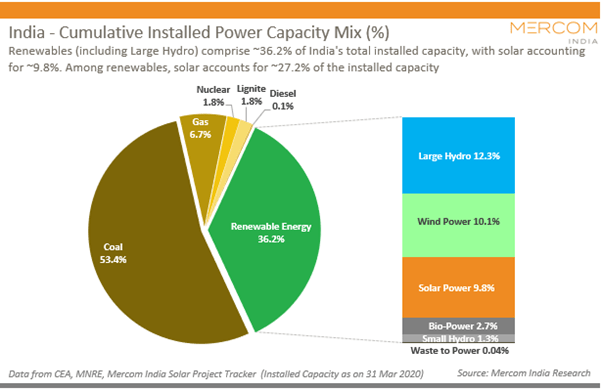Environment & Ecology
Context:
- Livelihoods powered by clean energy are major outliers in the country that’s the third-largest emitter of planet-warming gases in the world
- India missed its target to install 175 gigawatts of renewable energy to its overall power production by 2022.
- To meet its 2030 renewable energy target of installing a total of 450 gigawatts, India needs to build out clean energy at a far greater rate than it is doing now.
Role of coal in India’s Energy mix

- Coal is by far the largest share of dirty fuels.
- Nationwide fossil fuels generate more than 70% of India’s electricity and have been doing so for decades.
- The Indian government has repeatedly defended its use of coal and its energy transition strategy, stating that the fuel is necessary for the nation’s energy security.
- In 2021, India announced its biggest-ever auction for coal mines inviting bids for 141 mines spread across 12 states in the country
- It will contribute to its target of producing 1 billion tons of coal by April 2024.
- From 2001 to 2021, India installed 168 gigawatts of coal-fired generation, nearly double what it added in solar and wind power combined, as per Ember data.
- Coal India limited, a government-owned company, is the largest state-owned coal producer in the world.
- It is responsible for about 82% of the total coal produced in India.
- The country’s coal-fired power plants have an average age of 13 years and India has 91,000 MW of new proposed coal capacity in the works, second only to China
- According to the Draft National Electricity Plan 2022, coal’s share in the electricity generation mix will decrease to 50% by 2030, compared to the current contribution of 70%
Status of Renewable energy
- Contribution It currently contributes about 10% of India’s electricity needs.
- Price of renewable energy has plummeted.
- The cost of solar power has dropped roughly sixfold from 12 rupees (14 cents) per kilowatt-hour in 2011 to 2.5 rupees (0.03 cents) per kilowatt-hour.
- Economic savings The planned buildout of 76 GW of solar and wind power by 2025 will avoid the use of almost 78 million tons of coal annually and could lead to savings of up to 1.6 trillion rupees ($19.5 billion) per year.
- Gujarat
- Coal’s share in producing electricity for Gujarat fell from 85% to 56% in the last six years, according to analysis by London-based energy think tank Ember
- The share of renewable energy for Gujarat grew from 9% to 28% in the same period.
- Gujarat is one of four of India’s 28 states that met their renewable energy targets for 2022.
- Other states Most states have installed less than 50% of their targets and some states such as West Bengal have installed only 10% of their target.
Challenges in transition
- Reducing the share of coal in the electricity generation mix is particularly acute because the sector is growing rapidly
- Development goals India’s quickly developing economy and growing electricity consumption per capita is causing rising demand
- Historically, countries that have achieved substantial and rapid transitions away from coal-fired power tend to have had either slowly growing or stagnant or even slightly declining electricity demand
- Growing demand India’s federal power ministry estimates that its electricity demand will grow up to 6% every year for the next decade.
- Acquiring land for clean energy projects in tough due to resistance from local communities.
- While longstanding contracts with coal plants also make it easier for state-run electricity companies to buy coal power instead of clean power.
- Inefficiency of DISCOMS As of December 2022, Indian state-owned electricity distribution companies owed power generators $3.32 billion in overdue payments.
- Their poor financial health has dampened their ability to invest in clean energy projects
- Skewed Lending scenario 60% of lending to the mining sector was for oil and gas extraction, while one-fifth of manufacturing sector debt is for petroleum refining and related industries.
- High-carbon industries — power generation, chemicals, iron and steel, and aviation — account for 10% of outstanding debt to Indian financial institutions. However, these industries are also heavily indebted, and therefore have less financial capacity to respond to shocks and stresses.
Suggestions for future:
- Planning It is great that India has a 2070 net zero target, but changes need to happen now for us to achieve this.
- Building renewables capacity and energy storage– electricity distribution companies need to allow for more rooftop solar installations even if it results in short-term economic losses for them.
- Investing in modernizing and building new wind energy projects will also speed up the transition.
- India needs $223 billion to meet 2030 renewable capacity goals
- Enacting more progressive policies — such as the $2.6 billion government scheme that encourages making components required to produce solar energy — and ensuring these policies are being implemented is essential to speed up a move toward renewables
- New laws such as the energy conservation bill as well as updated mandates issued by the federal government that make it necessary for electricity companies to purchase renewables provide hope
- Investment in new technology such as clean fuels like green hydrogen may improve battery storage for renewables to provide uninterrupted electricity
- Sovereign green bonds India is expected to launch its first-ever sovereign green bonds auction, with the Reserve Bank of India
Way forward
- A report by the Global Energy Monitor ranks India among the top seven countries globally for prospective renewable power.
- At the end of the day what is needed is speeding up the installation of renewables and associated infrastructure
- Ultimately in India, renewable energy is a highly cost-effective technology. The perception that coal is cheap is changing
Source: Indian express













